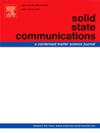MZnOS (M = Ca, Sr)的弹性性质及应变对晶体结构和带隙的影响:第一性原理研究
IF 2.1
4区 物理与天体物理
Q3 PHYSICS, CONDENSED MATTER
引用次数: 0
摘要
机械发光(ML)材料,如CaZnOS和SrZnOS,在照明、传感器和可穿戴设备中显示出巨大的潜力。尽管对这些材料的理解有所进展,但对应变-应力关系及其对晶体结构和带隙的影响的详细第一性原理研究尚缺乏。在这项工作中,我们使用第一性原理计算来研究两种MZnOS (M = Ca, Sr)化合物的弹性性质,晶体结构变形和应变下的带隙响应,填补了目前对这些材料的理解的空白。计算了SrZnOS和CaZnOS的弹性常数、弹性模量和泊松比,揭示了静水压力对晶格参数和原子距离的影响。值得注意的是,SrZnOS和CaZnOS在拉伸应变和压缩应变下沿[100]和[001]方向表现出不同的力学行为。在压应力作用下,特别是沿[100]方向,CaZnOS表现出比SrZnOS更大的抗压能力。此外,还观察到了应变引起的带隙变化:SrZnOS的带隙随着应变的增加而减小,而CaZnOS在压缩载荷(0-2.34 GPa)下,带隙沿[001]方向初始变宽。我们的发现为MZnOS材料的力学和电子行为提供了新的见解,这对其在机械发光和其他相关领域的应用至关重要。本文章由计算机程序翻译,如有差异,请以英文原文为准。
The elastic properties and strain effects on crystal structures and bandgap of MZnOS (M = Ca, Sr): A first-principles study
Mechanoluminescence (ML) materials, such as CaZnOS and SrZnOS, show great potential in lighting, sensors, and wearable devices. Despite advances in the understanding of these materials, a detailed first-principles study of the strain-stress relationship and the effects on crystal structure and bandgap is lacking. In this work, we use first-principles calculations to investigate the elastic properties, crystal structure deformations, and bandgap responses under strain for both MZnOS (M = Ca, Sr) compounds, filling the gap in the current understanding of these materials. The elastic constants, elastic modulus and Poisson's ratios for SrZnOS and CaZnOS are calculated, revealing the influence of hydrostatic pressure on lattice parameters and atomic distances. Notably, the stress-strain relationships of SrZnOS and CaZnOS reveal distinct mechanical behaviors under tensile and compressive strains along the [100] and [001] directions. Under compressive stress, especially along the [100] direction, CaZnOS shows greater compressive resistance than SrZnOS. Additionally, strain-induced bandgap variations are observed: SrZnOS exhibits a decrease in bandgap with increasing strain, while CaZnOS shows an initial bandgap widening under compressive loading (0–2.34 GPa) along the [001] direction. Our findings provide new insights into the mechanical and electronic behavior of MZnOS materials, which are crucial for their application in mechanoluminescence and other related fields.
求助全文
通过发布文献求助,成功后即可免费获取论文全文。
去求助
来源期刊

Solid State Communications
物理-物理:凝聚态物理
CiteScore
3.40
自引率
4.80%
发文量
287
审稿时长
51 days
期刊介绍:
Solid State Communications is an international medium for the publication of short communications and original research articles on significant developments in condensed matter science, giving scientists immediate access to important, recently completed work. The journal publishes original experimental and theoretical research on the physical and chemical properties of solids and other condensed systems and also on their preparation. The submission of manuscripts reporting research on the basic physics of materials science and devices, as well as of state-of-the-art microstructures and nanostructures, is encouraged.
A coherent quantitative treatment emphasizing new physics is expected rather than a simple accumulation of experimental data. Consistent with these aims, the short communications should be kept concise and short, usually not longer than six printed pages. The number of figures and tables should also be kept to a minimum. Solid State Communications now also welcomes original research articles without length restrictions.
The Fast-Track section of Solid State Communications is the venue for very rapid publication of short communications on significant developments in condensed matter science. The goal is to offer the broad condensed matter community quick and immediate access to publish recently completed papers in research areas that are rapidly evolving and in which there are developments with great potential impact.
 求助内容:
求助内容: 应助结果提醒方式:
应助结果提醒方式:


